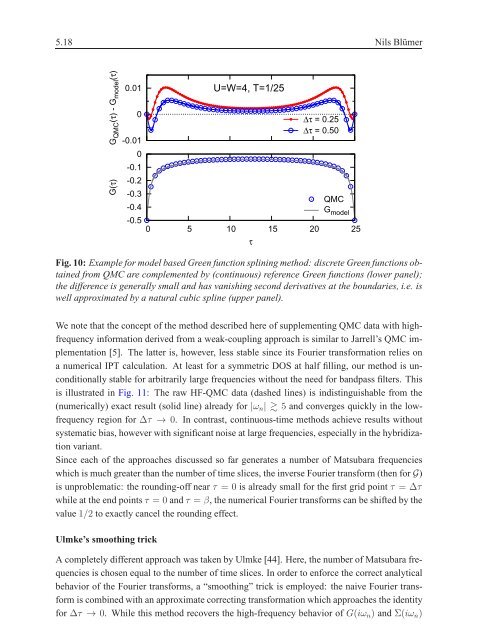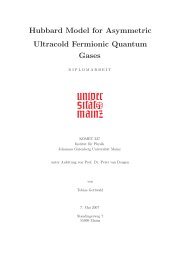5 Hirsch-Fye quantum Monte Carlo method for ... - komet 337
5 Hirsch-Fye quantum Monte Carlo method for ... - komet 337
5 Hirsch-Fye quantum Monte Carlo method for ... - komet 337
Create successful ePaper yourself
Turn your PDF publications into a flip-book with our unique Google optimized e-Paper software.
5.18 Nils Blümer<br />
G QMC (τ) - G model (τ)<br />
G(τ)<br />
0.01<br />
0<br />
-0.01<br />
0<br />
-0.1<br />
-0.2<br />
-0.3<br />
-0.4<br />
-0.5<br />
U=W=4, T=1/25<br />
0 5 10 15 20 25<br />
τ<br />
∆τ = 0.25<br />
∆τ = 0.50<br />
QMC<br />
G model<br />
Fig. 10: Example <strong>for</strong> model based Green function splining <strong>method</strong>: discrete Green functions obtained<br />
from QMC are complemented by (continuous) reference Green functions (lower panel);<br />
the difference is generally small and has vanishing second derivatives at the boundaries, i.e. is<br />
well approximated by a natural cubic spline (upper panel).<br />
We note that the concept of the <strong>method</strong> described here of supplementing QMC data with highfrequency<br />
in<strong>for</strong>mation derived from a weak-coupling approach is similar to Jarrell’s QMC implementation<br />
[5]. The latter is, however, less stable since its Fourier trans<strong>for</strong>mation relies on<br />
a numerical IPT calculation. At least <strong>for</strong> a symmetric DOS at half filling, our <strong>method</strong> is unconditionally<br />
stable <strong>for</strong> arbitrarily large frequencies without the need <strong>for</strong> bandpass filters. This<br />
is illustrated in Fig. 11: The raw HF-QMC data (dashed lines) is indistinguishable from the<br />
(numerically) exact result (solid line) already <strong>for</strong> |ωn| � 5 and converges quickly in the lowfrequency<br />
region <strong>for</strong> ∆τ → 0. In contrast, continuous-time <strong>method</strong>s achieve results without<br />
systematic bias, however with significant noise at large frequencies, especially in the hybridization<br />
variant.<br />
Since each of the approaches discussed so far generates a number of Matsubara frequencies<br />
which is much greater than the number of time slices, the inverse Fourier trans<strong>for</strong>m (then <strong>for</strong>G)<br />
is unproblematic: the rounding-off near τ = 0 is already small <strong>for</strong> the first grid point τ = ∆τ<br />
while at the end pointsτ = 0 andτ = β, the numerical Fourier trans<strong>for</strong>ms can be shifted by the<br />
value1/2 to exactly cancel the rounding effect.<br />
Ulmke’s smoothing trick<br />
A completely different approach was taken by Ulmke [44]. Here, the number of Matsubara frequencies<br />
is chosen equal to the number of time slices. In order to en<strong>for</strong>ce the correct analytical<br />
behavior of the Fourier trans<strong>for</strong>ms, a “smoothing” trick is employed: the naive Fourier trans<strong>for</strong>m<br />
is combined with an approximate correcting trans<strong>for</strong>mation which approaches the identity<br />
<strong>for</strong> ∆τ → 0. While this <strong>method</strong> recovers the high-frequency behavior of G(iωn) and Σ(iωn)













